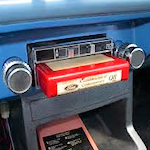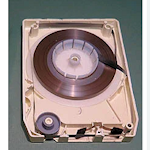In addition to vinyl records, a significant amount of classic rock music, in its heyday, was consumed on 8-track tapes.

The 8-track tape player, also known simply as the 8-track player, was a popular audio playback technology that gained prominence in the mid-1960s and remained popular throughout the 1970s. It was a significant development in the history of portable and in-car audio entertainment.
The 8-track tape format was developed by Bill Lear, the inventor of the Learjet and founder of Lear Incorporated. Lear, along with his team, sought to create a reliable and convenient way for people to enjoy music in their cars. The 8-track cartridge was their solution.
Introduction:
The first commercially available 8-track tape player was launched by Lear in 1965 under the name "Stereo 8." This new format was designed to provide continuous playback of music without the need to flip or rewind the tape, making it particularly well-suited for in-car entertainment.
How It Worked:

The design removed the need to wind and rewind the tape between a supply reel and a take-up reel by creating an endless loop. The coil of tape was spooled somewhat loosely around a hub on a rotating disk platform. The tape threaded from the center of the coil, out to a series of openings in the leading edge of the cartridge, then back to the outside of the coil.
A graphite coating on the back of the tape served as a dry lubricant to keep the tape and mechanism flowing smoothly. This would also necessitate the need for frequent cleaning of the tape head and drive mechanism. Q-tips and isopropyl alcohol, or commercially available head cleaning cartridges were typically used to remove the graphite build-up from the playback head.
The openings on the leading edge of the cartridge accommodated contact with a track change sensor, the playback head, and the capstan roller to drive the tape.
The term "8-track" is derived from the fact that on the 1/4" wide tape, there are four pairs of left-right stereo channels, arranged (from top to bottom) L1/L2/L3/L4/R1/R2/R3/R4. This arrangement quadrupled the amount of playback time over two stereo track tapes of the same width, but at the expense of frequency response.
The ends of the tape loop were joined by a short strip of metallic adhesive tape. When this strip passed across the track change sensor, the mechanism would physically move the playback head down to read the next pair of stereo tracks.
Since the mechanism and tapes could not be engineered with enough precision to match the head to the tape in every instance, an adjustment control allowed for the fine tuning of the head-to-tape contact in order to prevent "crosstalk" from one of the other pairs of tracks being audible during playback.
Sometimes, certain tapes would refuse to play without crosstalk, no matter the control setting. Often, stuffing a matchbook or some folded cardboard under the inserted cartridge would solve the problem.
A rubberized pinch roller was integrated into every tape cartridge, negating the need for it to be a part of the player mechanism, and more importantly providing the ability for the cartridge to be inserted and removed without any interaction with the player.
Car Audio Dominance:
Ford Motor Company became the first American car manufacturer to offer an 8-track tape player as an option on its 1966 Mustang, Thunderbird and Lincoln models. In conjunction, RCA Victor issued 175 Stereo-8 cartridges from their catalog of artists on its RCA Victor and RCA Camden record labels. By the 1967 model year, all Ford vehicles offered the 8-track tape player as an option.
Home 8-track players were not yet widely available, and until the format reached a level of market saturation to be offered in music stores, consumers had to visit a Ford dealership to purchase the new tapes.
Nevertheless, the 8-track player quickly gained popularity, becoming a standard feature in many automobiles during the late 1960s and throughout the 1970s. It was a significant improvement over the earlier in-car record players, which were prone to skipping and damage.
Music Industry Adoption:
Major record labels embraced the 8-track format, releasing a wide range of albums on 8-track tapes. This helped boost the format's popularity, as consumers could now enjoy their favorite music on the go.
Home Audio:
In addition to car audio, 8-track players were also available for home use. They were often integrated into home phono/AM/FM stereo systems and were commonly found in living rooms across the United States during the 1970s. Home 8-track recorders would also become available, although not as popular as playback-only units.
Limitations:
Despite its popularity, the 8-track format had some limitations. The most notable was the need to split albums into four programs, which often resulted in awkward breaks between tracks. Additionally, the tape itself was prone to wear and tear, which could lead to audio quality degradation over time.
The endless loop configuration also meant the tape could not be rewound to an earlier point in a program, only played or fast-forwarded.
Decline:
By the late 1970s, newer audio formats, such as the compact cassette and eventually the Sony Walkman, began to eclipse the 8-track tape player. These formats offered better sound quality, portability, and more convenient features. As a result, 8-track sales started to decline.
Obsolescence:
By the early 1980s, the production and availability of 8-track tapes and players had significantly decreased, and the format was largely phased out. Collectors and enthusiasts still appreciate 8-track players and tapes as nostalgic artifacts of the era.
Legacy:
While the 8-track format is mostly a relic of the past, it played a crucial role in the evolution of portable and in-car audio technology. It also left a lasting mark on popular culture, with references to 8-tracks often appearing in music, films, and television shows as symbols of the 1970s.
Today, 8-track tapes and players are collectors' items, and some people still enjoy the nostalgic experience of listening to music on this vintage format. However, for mainstream audio playback, the 8-track has been replaced by more advanced and convenient technologies.
